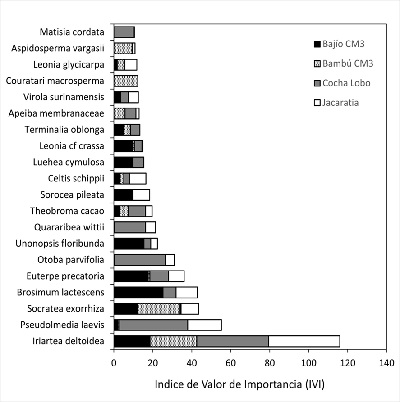Flora arbórea de los bosques de la planicie aluvial inundable en el Río Los Amigos, Amazonia Peruana
DOI:
https://doi.org/10.55873/rba.v3i1.274Palabras clave:
bosque aluvial inundable, composición florística, flora arbórea, río Los AmigosResumen
El presente estudio describe la flora arbórea y su estructura registrada en cuatro parcelas de 1 hectárea en los bosques de la planicie aluvial inundable adyacentes a los ríos Los Amigos y Madre de Dios en el Sureste del Perú. Un total de 317 especies, 188 géneros y 61 familias fueron registrados en las cuatro parcelas. La variación de especies por hectárea fue de 121–156, los géneros de 88–112 y las familias de 36–46. Se ha registrado una densidad de individuos arbóreos de 299–574 y un área basal de 18,23–32,58 m2 por hectárea. Las especies más abundantes fueron las palmeras y árboles del estrato medio del bosque como Iriartea deltoidea, Pseudolmedia laevis y Euterpe precatoria en las parcelas de Bajío CM3, Cocha Lobo y Jacaratia. En la Parcela Bambú CM3 las especies más abundantes son Iriartea deltoidea y Socratea exorrhiza. Las familias más abundantes fueron Arecaceae, Moraceae y Malvaceae.
Citas
Angiosperm Phylogeny Group, Chase, M. W., Christenhusz, M. J. M., Fay, M. F., Byng, J. W., Judd, W. S., Soltis, D. E., Mabberley, D. J., Sennikov, A. N., Soltis, P. S., & Stevens, P. F. (2016). An update of the Angiosperm Phylogeny Group classification for the orders and families of flowering plants: APG IV. Botanical Journal of the Linnean Society, 181(1), 1–20. https://doi.org/10.1111/boj.12385
Campbell, D. G., Daly, D. C., Prance, G. T., & Maciel, U. N. (1986). Quantitative Ecological Inventory of Terra Firme and Varzea Tropical Forest on the Rio Xingu, Brazilian Amazon. Brittonia, 38(4), 369. https://doi.org/10.2307/2807085
Dushku, A., & Undo, A. (2006). Protecting the influence zone around the Los Amigos conservation concession, Madre de Dios, Peru (p. 56). Winrock International.
Goulding, M. (2003). Amazon headwaters: rivers, wildlife, and conservation in southeastern Peru. (1st ed.). Asociación para la Conservación de la Cuenca Amazónica.
Griscom, B. W., & Ashton, P. M. S. (2003). Bamboo control of forest succession: Guadua sarcocarpa in Southeastern Peru. Forest Ecology and Management, 175(1–3), 445–454. https://doi.org/10.1016/S0378-1127(02)00214-1
Hamilton, S. K., Kellndorfer, J., Lehner, B., & Tobler, M. (2007). Remote sensing of floodplain geomorphology as a surrogate for biodiversity in a tropical river system (Madre de Dios, Peru). Geomorphology, 89(1–2), 23–38. https://doi.org/10.1016/j.geomorph.2006.07.024
Nebel, G., Kvist, L. P., Vanclay, J. K., Christensen, H., Freitas, L., & Ruı́z, J. (2001). Structure and floristic composition of flood plain forests in the Peruvian Amazon. Forest Ecology and Management, 150(1–2), 27–57. https://doi.org/10.1016/S0378-1127(00)00680-0
Pitman, N. C. A., Núñez Vargas, M. P., & Terborgh, J. W. (2005). Árboles comunes de los bosques inundados de Madre de Dios (1; 1). https://static1.squarespace.com/static/5b33aa0bee175914bd4c4f5b/t/5b65dab303ce647540efc04d/1533401780053/arboles-ms-pitman2.pdf
Pitman, N. C. A., Terborgh, J., Silman, M. R., & Nunez V, P. . (1999). Tree Species Distributions in an Upper Amazonian Forest. Ecology, 80(8), 2651. https://doi.org/10.2307/177247
Pitman, N. C. A., Terborgh, J. W., Silman, M. R., Núñez V, P., Neill, D. A., Cerón, C. E., Palacios, W. A., & Aulestia, M. (2001). Dominance and distribution of tree species in upper Amazonian terra firme forests. Ecology. Ecology, 82(8), 2101–2117. https://esajournals.onlinelibrary.wiley.com/doi/abs/10.1890/0012-9658(2001)082%5B2101:DADOTS%5D2.0.CO%3B2
Puhakka, M., Kalliola, R., & Danjoy, W. (1993). Floodplain vegetation mosaics in western Amazonia. Biogeographica, 71(1), 1–14. http://www.sidalc.net/cgi-bin/wxis.exe/?IsisScript=P-LIM.xis&method=post&formato=2&cantidad=1&expresion=mfn=004072
Räsänen, M. E., Salo, J. S., Jungnert, H., & Pittman, L. R. (1990). Evolution of the Western Amazon Lowland Relief: impact of Andean foreland dynamics. Terra Nova, 2(4), 320–332. https://doi.org/10.1111/j.1365-3121.1990.tb00084.x
Salo, J., Kalliola, R., Häkkinen, I., Mäkinen, Y., Niemelä, P., Puhakka, M., & Coley, P. D. (1986). River dynamics and the diversity of Amazon lowland forest. Nature, 322(6076), 254–258. https://doi.org/10.1038/322254a0
Swamy, V. (2017). Forest Composition and Spatial Patterns across a Western Amazonian River Basin: The Influence of Plant–Animal Interactions. In Forest structure, function and dynamics in Western Amazonia (pp. 159–180). Wiley. https://doi.org/10.1002/9781119090670.ch8
Ter Steege, H., Pitman, N. C. A., Sabatier, D., Baraloto, C., Salomão, R. P., Guevara, J. E., Phillips, O. L., Castilho, C. V., Magnusson, W. E., Molino, J.-F., Monteagudo, A., Núñez Vargas, P., Montero, J. C., Feldpausch, T. R., Coronado, E. N. H., Killeen, T. J., Mostacedo, B., Vasquez, R., Assis, R. L., … Silman, M. R. (2013). Hyperdominance in the Amazonian Tree Flora. Science, 342(6156). https://doi.org/10.1126/science.1243092
Thieme, M., Lehner, B., Abell, R., Hamilton, S. K., Kellndorfer, J., Powell, G., & Riveros, J. C. (2007). Freshwater conservation planning in data-poor areas: An example from a remote Amazonian basin (Madre de Dios River, Peru and Bolivia). Biological Conservation, 135(4), 484–501. https://doi.org/10.1016/j.biocon.2006.10.054
Tobler, M. W., Carrillo‐Percastegui, S. E., Leite Pitman, R., Mares, R., & Powell, G. (2008). An evaluation of camera traps for inventorying large‐ and medium‐sized terrestrial rainforest mammals. Animal Conservation, 11(3), 169–178. https://doi.org/10.1111/j.1469-1795.2008.00169.x
Tuomisto, H., Poulsen, A. D., Ruokolainen, K., Moran, R. C., Quintana, C., Celi, J., & Cañas, G. (2005). Linking floristic patterns to edaphic gradients and remote sensing in Peruvian Amazonia. Ecological Applications, 13(2), 352–371. https://doi.org/https://doi.org/10.1890/1051-0761(2003)013[0352:LFPWSH]2.0.CO;2
Wittmann, F., Householder, E., Piedade, M. T. F., de Assis, R. L., Schöngart, J., Parolin, P., & Junk, W. J. (2013). Habitat specifity, endemism and the neotropical distribution of Amazonian white‐water floodplain trees. Ecography, 36(6), 690–707. https://doi.org/10.1111/j.1600-0587.2012.07723.x

Descargas
Publicado
Cómo citar
Número
Sección
Licencia
Derechos de autor 2024 César Inocensio Vela-Apaza, Therany Gonzales-Ojeda

Esta obra está bajo una licencia internacional Creative Commons Atribución 4.0.







